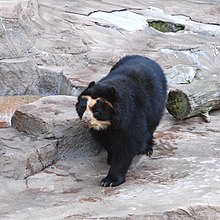Tremarctinae
| Tremarctinae Temporal range:
| |
|---|---|

| |
| A spectacled bear in Tennōji Zoo, Osaka. | |
| Scientific classification | |
| Domain: | Eukaryota |
| Kingdom: | Animalia |
| Phylum: | Chordata |
| Class: | Mammalia |
| Order: | Carnivora |
| Family: | Ursidae |
| Subfamily: | Tremarctinae Merriam & Stock, 1925 |
| Genera | |
The Tremarctinae or short-faced bears is a subfamily of Ursidae that contains one living representative, the spectacled bear (Tremarctos ornatus) of South America, and several extinct species from four genera: the Florida spectacled bear (Tremarctos floridanus), the North American short-faced bears of genera Plionarctos (P. edensis and P. harroldorum) and Arctodus (A. pristinus and A. simus), and the South American giant short-faced bears of Arctotherium (including A. angustidens, A. vetustum, A. bonariense, A. wingei, and A. tarijense).[1]
Systematics
Traditionally the phylogenetic inner relationships of tremarctines had Plionarctos and Tremarctos being basal groups with respect to a short-faced bear clade of Arctodus and Arctotherium.[2][3] A study of the affinities of bears belonging to Arctotherium indicates that they were more closely related to the spectacled bear than to Arctodus.[4]
Taxonomy
The following taxonomy of the tremarctine bears follow by Mitchell et al. (2016)[4]:
- Subfamily Tremarctinae (Merriam & Stock, 1925)
- †Plionarctos (Frick, 1926)
- †Plionarctos harroldorum (Tedfored & Martin, 2001)
- †Plionarctos edensis (Frick, 1926)
- †Arctodus (Leidy, 1854)
- †Arctodus simus (Cope, 1879)
- †Arctodus pristinus (Leidy, 1854)
- †Arctotherium (Burmeister, 1879)
- †Arctotherium angustidens (Gervais & Ameghino, 1880)
- †Arctotherium vetustum (Ameghino, 1885)
- †Arctotherium wingei (Ameghino, 1902)
- †Arctotherium bonariense (Gervais, 1852)
- †Arctotherium tarijense (Ameghino, 1902)
- Tremarctos (Gervais, 1855)
- †Tremarctos floridanus (Gildey, 1928)
- Tremarctos ornatus (Cuvier, 1825) – Spectacled Bear
- †Plionarctos (Frick, 1926)
See also
References
- ^ Krause, J.; Unger, T.; Noçon, A.; Malaspinas, A.; Kolokotronis, S.; Stiller, M.; Soibelzon, L.; Spriggs, H.; Dear, P. H.; Briggs, A. W.; Bray, S. C. E.; O'Brien, S. J.; Rabeder, G.; Matheus, P.; Cooper, A.; Slatkin, M.; Pääbo, S.; Hofreiter, M. (2008-07-28). "Mitochondrial genomes reveal an explosive radiation of extinct and extant bears near the Miocene-Pliocene boundary". BMC Evolutionary Biology. 8: 220. doi:10.1186/1471-2148-8-220. PMC 2518930. PMID 18662376.
{{cite journal}}: CS1 maint: unflagged free DOI (link) - ^ Soibelzon, Leopoldo H.; Rincón, Ascanio D. (2007). "The fossil record of the short-faced bears (Ursidae, Tremarctinae) from Venezuela. Systematic, biogeographic, and paleoecological implications". Neues Jahrbuch für Geologie und Paläontologie, Abhandlungen. 244 (3): 287–298. doi:10.1127/0077-7749/2007/0244-0287.
- ^ Soibelzon, Leopoldo H.; Schubert, Blaine W. (2011). "The largest known bear, Arctotherium angustidens, from the early Pleistocene pampean region of Argentina: with a discussion of size and diet trends in bears". Journal of Paleontology. 85 (01): 69–75. doi:10.1666/10-037.1.
- ^ a b "Ancient mitochondrial DNA reveals convergent evolution of giant short-faced bears (Tremarctinae) in North and South America". Biology Letters. 12 (4): 20160062. 2016. doi:10.1098/rsbl.2016.0062. PMC 4881349. PMID 27095265.
{{cite journal}}: Unknown parameter|authors=ignored (help)
External links
